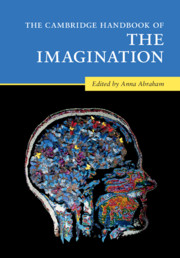Book contents
- The Cambridge Handbook of the Imagination
- The Cambridge Handbook of the Imagination
- Copyright page
- Dedication
- Contents
- Figures
- Contributors
- Acknowledgments
- 1 Surveying the Imagination Landscape
- Part I Theoretical Perspectives on the Imagination
- Part II Imagery-Based Forms of the Imagination
- Part III Intentionality-Based Forms of the Imagination
- Part IV Novel Combinatorial Forms of the Imagination
- Part V Phenomenology-Based Forms of the Imagination
- 34 Imagination in the Philosophy of Art
- 35 Imagination in Aesthetic Experience
- 36 The Arts and Human Symbolic Cognition: Art is for Social Communication
- 37 Aesthetic Engagement: Lessons from Art History, Neuroscience, and Society
- 38 Dance and the Imagination: Be a Butterfly!
- 39 Imagination, Intersubjectivity, and a Musical Therapeutic Process: A Personal Narrative
- Part VI Altered States of the Imagination
- Name Index
- Subject Index
- References
35 - Imagination in Aesthetic Experience
from Part V - Phenomenology-Based Forms of the Imagination
Published online by Cambridge University Press: 26 May 2020
- The Cambridge Handbook of the Imagination
- The Cambridge Handbook of the Imagination
- Copyright page
- Dedication
- Contents
- Figures
- Contributors
- Acknowledgments
- 1 Surveying the Imagination Landscape
- Part I Theoretical Perspectives on the Imagination
- Part II Imagery-Based Forms of the Imagination
- Part III Intentionality-Based Forms of the Imagination
- Part IV Novel Combinatorial Forms of the Imagination
- Part V Phenomenology-Based Forms of the Imagination
- 34 Imagination in the Philosophy of Art
- 35 Imagination in Aesthetic Experience
- 36 The Arts and Human Symbolic Cognition: Art is for Social Communication
- 37 Aesthetic Engagement: Lessons from Art History, Neuroscience, and Society
- 38 Dance and the Imagination: Be a Butterfly!
- 39 Imagination, Intersubjectivity, and a Musical Therapeutic Process: A Personal Narrative
- Part VI Altered States of the Imagination
- Name Index
- Subject Index
- References
Summary
Imagination – either explicitly or implicitly – plays an important role in contemporary conceptions of creativity. In contrast, imagination has not been given the same weight in most mainstream modern models of aesthetic experience. I argue that imagination is an important component of aesthetic experience in at least two ways. First, imagination likely guides our search for meaning when interacting with artworks. It can do so by driving our search for the underlying concepts and causes that originated the artwork, as well as facilitating internally generated thoughts. Second, imagination can facilitate transitions from states of uncertainty to states of increased predictability in the course of interacting with artworks. As such, models of aesthetic experience would benefit by explicitly incorporating imagination into their frameworks.
- Type
- Chapter
- Information
- The Cambridge Handbook of the Imagination , pp. 578 - 592Publisher: Cambridge University PressPrint publication year: 2020
References
- 2
- Cited by



